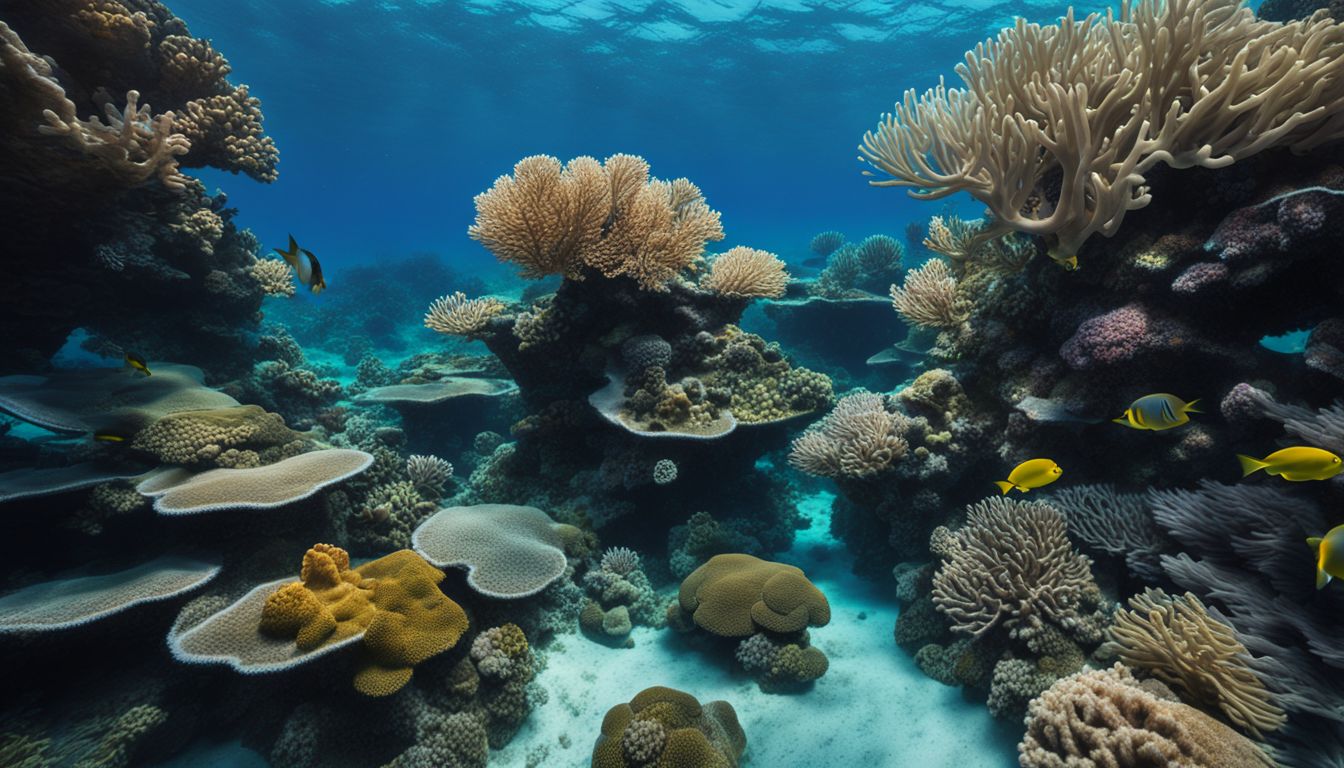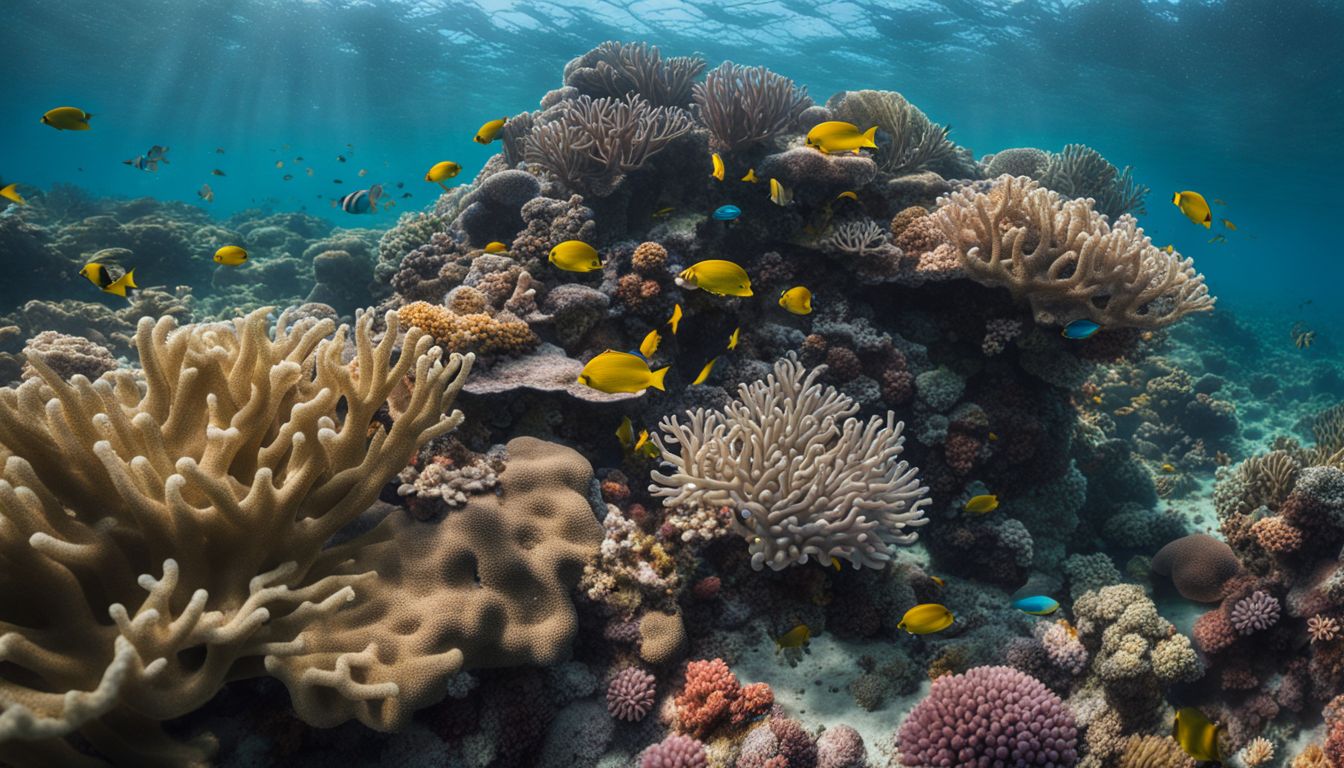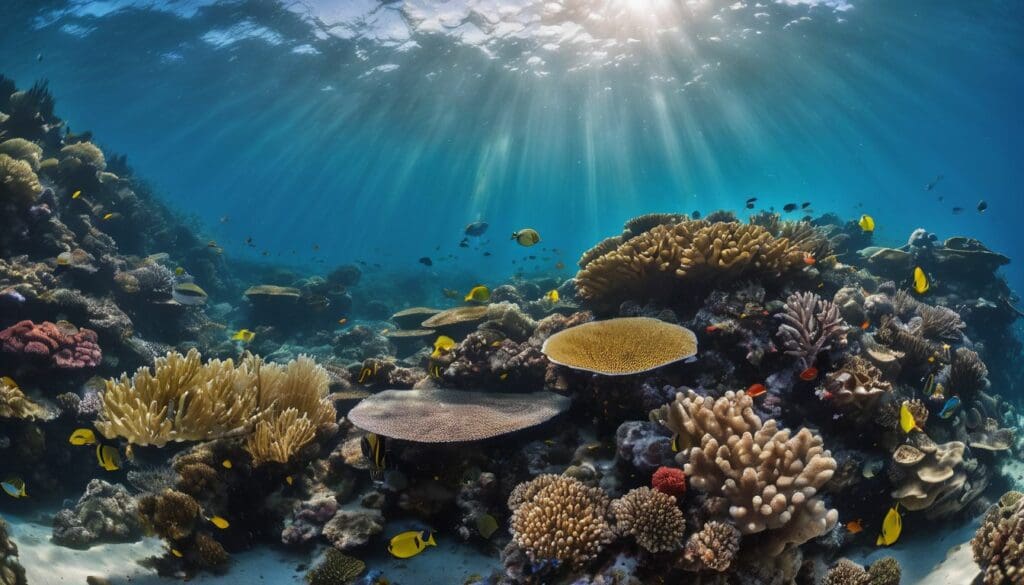Witnessing the hauntingly pale canvases that once throbbed with life, our hearts weigh heavy at the sight of corals succumbing to the merciless phenomenon of bleaching. Just like you, we find ourselves grappling with a sense of unease as this underwater calamity unfolds.
Astonishingly, we’ve already bid farewell to half of the planet’s coral reefs over recent years. Our commitment lies in identifying and promoting impactful measures that could help safeguard these irreplaceable marine habitats.
Immerse yourself in our findings and become an ally in securing a resilient future for our coral reefs.
Key Takeaways
- Coral bleaching is a severe issue caused by global warming, leading to the loss of zooxanthellae, the algae that provide corals with food through photosynthesis.
- Rising sea temperatures not only bleach corals but also disrupt marine ecosystems and affect human communities that rely on fishing and tourism.
- Half of the world’s coral reefs have disappeared in recent years due to factors like climate change, ocean acidification, and harmful human activities.
- Protective measures such as establishing Marine Protected Areas (MPAs) and reducing fossil fuel emissions are crucial for preserving these delicate marine habitats.
- Immediate action is needed to combat coral reef bleaching by supporting renewable energy, sustainable fisheries, eco-friendly tourism, and conservation strategies.
Understanding Coral Bleaching

In our quest to understand coral bleaching, we delve into the triggers and repercussions of this marine catastrophe. It’s a global phenomenon that not only pales these vibrant ecosystems but also unravels the fabric of ocean life as we know it.
Causes and Effects
We see our oceans warming due to climate change, and this leads to coral bleaching. The fragile zooxanthellae that live in the corals get stressed by higher water temperatures and abandon their hosts.
This leaves coral polyps without their main source of food and a critical energy source, causing them to turn white and weaken. Many factors contribute to rising sea temperatures – from greenhouse gas emissions due to fossil fuel burning, deforestation, and industrial processes.
As marine ecosystems suffer from this thermal stress, the ripple effects are profound. Bleached corals struggle to provide habitat for countless marine species, placing food security at risk for millions who depend on fish as a primary protein source.
Moreover, weakened coral reefs offer less protection against storms, leading to greater coastal erosion and damage during tropical cyclones or extreme weather events. It is clear that preserving our oceans isn’t just about saving beautiful underwater landscapes; it’s essential for protecting biodiversity and human communities alike.
Global Impact of Coral Bleaching
Coral bleaching reaches far beyond the loss of colour in our ocean’s reefs. It signals a global crisis that touches every corner of marine life and impacts communities dependent on healthy oceans.
As rising sea surface temperatures push corals to expel the algae they rely on, we witness vast stretches of once vibrant ecosystems turning ghostly white. This domino effect disrupts ocean food chains and threatens species, from small fish to charismatic sea turtles.
We must acknowledge how coral mortality jeopardises livelihoods around the world, especially in regions where fishing and tourism hinge upon flourishing reefs. Degraded by events like El Niño and continuous marine heatwaves caused by global heating, these natural treasures cease to provide critical coastal protection against tropical storms, further escalating risk for millions living near shorelines.
Our role extends beyond observers; it demands urgent action towards emissions reduction and a swift transition to renewable energy sources to safeguard our shared blue planet for future generations.
The State of Coral Reefs: A Crisis

Coral reefs, the rainforests of our oceans, are in a perilous state. They face a siege from climate change that has pushed them to a tipping point, endangering their very existence and the myriad forms of life they support.
The Link to Climate Breakdown
We see our planet heating up, and it’s not just the air. The oceans absorb most of this extra heat, causing marine heat waves that wreak havoc on coral reefs. As water temperatures rise, corals get stressed and expel the colourful algae living in their tissues.
This leads to bleaching events where once vibrant reefs turn ghostly white.
Our actions are at the heart of climate breakdown, which spells disaster for these ecosystems we cherish. Burning fossil fuels such as oil and gas pumps massive amounts of carbon dioxide into the atmosphere.
This greenhouse gas traps more sun’s warmth than our world is used to handling. It acidifies our oceans too, making it tougher for corals to build their calcium carbonate skeletons they need for support.
Each one of us has a carbon footprint – everything from energy consumption to how often we use eco-friendly products impacts our global ocean and its inhabitants.
The Impact on Wildlife and Humans
Coral reefs stand as bustling metropolises under the sea, supporting diverse marine life that relies on these habitats for survival. Mass coral bleaching events devastate these intricate ecosystems, causing fish populations to plummet and leaving countless species without food or shelter.
As we confront this climate crisis, our actions are crucial to safeguarding the ocean’s biodiversity.
On land, the repercussions of damaged coral reefs ripple through communities that depend on them. Coastal people face losing their primary source of income as fish stocks decline and once-bustling fisheries turn silent.
Our shared responsibility calls us to action; protecting tropical coral reefs is vital not only for marine creatures but also for human societies who rely on the health of our oceans to thrive.
Combating Coral Bleaching: The Urgency of Action
We must take immediate steps to combat coral bleaching, recognising the critical role these ecosystems play in our marine environment. With rising water temperatures due to climate change and ocean acidification from excess carbon dioxide, coral colonies face unprecedented stress.
We can support sustainable fisheries and promote eco-friendly tourism practices that minimise damage to reefs.
Our actions include creating and enforcing marine protected areas (MPAs) where human activity is regulated to help reef resilience. By reducing coastal development and implementing fishery management strategies, we protect habitats crucial for diverse species that depend on healthy coral systems.
Investing in renewables also cuts down on the burning of fossil fuels, a significant contributor to global warming. Together, with informed policy makers steering conservation efforts, we can address the impacts of climate change before it’s too late for our precious barrier reef ecosystems.
Conclusion
As we rally to protect our oceans, saving these magnificent coral reefs sits at the heart of marine conservation. With each step towards mitigating climate change, we aid their fight against bleaching.
Sustainable tourism and ecosystem management are vital in this battle. Let’s pledge our commitment to the seas and all that depends on them. Our actions now shape a thriving underwater world for generations to come.
FAQs
1. What is coral bleaching and why does it happen?
Coral bleaching occurs when corals lose their vibrant colours because the warm water temperatures force them to expel the algae living in their tissues.
2. How does climate change affect coral reefs?
The changing climate heats up our planet, causing sea level rise and warmer seas that lead to more frequent and severe coral bleaching events.
3. Why are places like the Great Barrier Reef so important?
The Great Barrier Reef is one of the most biodiverse ecosystems on Earth, home to thousands of marine species; it’s a vital habitat for conservation science to study.
4. What can we do to help protect coral reefs from bleaching?
To help save our reefs, we need sustainable tourism efforts, reduce greenhouse gases that warm our planet, adapt ecosystem management practices, and address overall climate change effects.
5. Are there any successful methods being used to combat coral reef crisis?
Scientists like Ove Hoegh-Guldberg advocate for reducing thermal coal usage which pollutes less, employing seawalls for physical protection against sea-level rise, and developing ways polyps can better adapt to a warming climate.
6. Can marine conservation societies make a difference in mitigating climate breakdowns’ impact on corals?
Absolutely! Organisations such as the Australian Marine Conservation Society work hard at mitigating the impacts of climate breakdowns by promoting policies and actions that aim at preserving these crucial underwater habitats.





